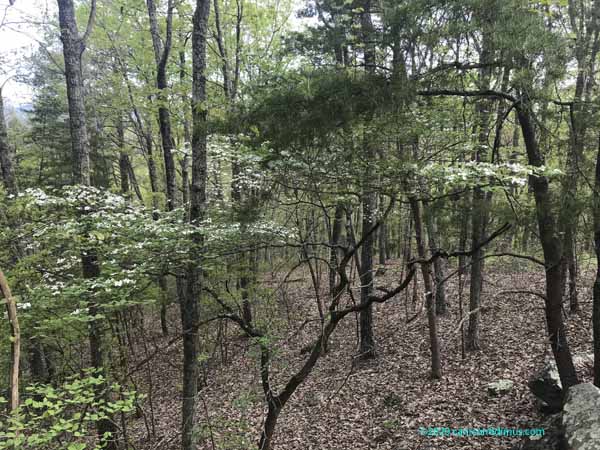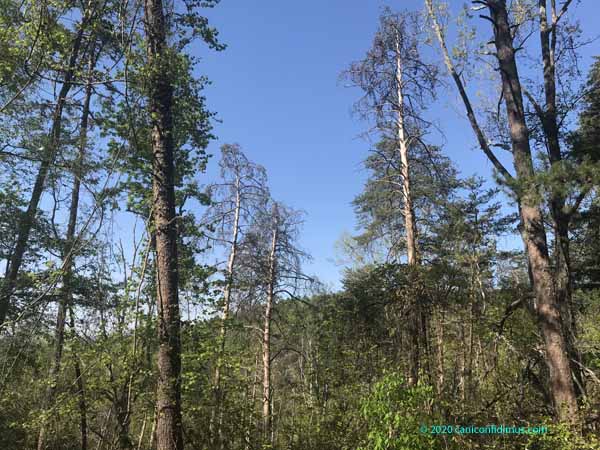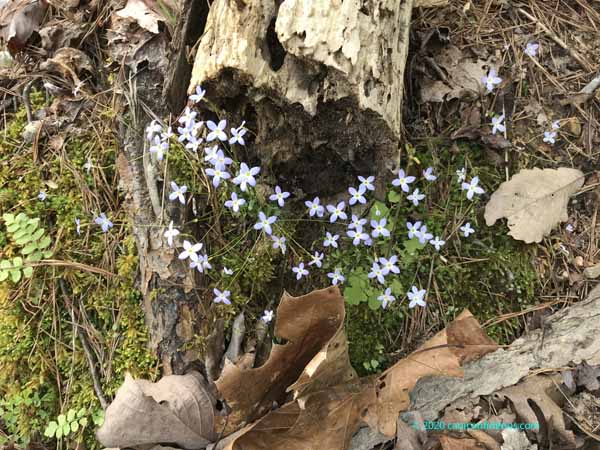We have been losing dogwoods for several years. I remember seeing the side of a nearby hill on my way home from Huntsville in early spring a few years ago. It seemed like hundreds of dogwoods were blooming on the bare slopes. Around here, just a few miles away, I have been cutting and burning dead dogwoods for some time. I keep an eye on the remaining trees as I walk the dogs and note which seem be dead. This spring we have been pleasantly surprised to see quite a few dogwoods blooming.

When I look out the window where I’m sitting right now, I can see four, or possibly five trees in bloom. I may be misremembering, but it seems that in past years dogwoods bloomed before most of the surrounding trees began to leaf out. This year it seems to be happening simultaneously, which makes it harder to see the flowering trees.
I’m not positive of the cause of the dogwood deaths. We have had a couple of recent summers that were very hot and very dry. There is also a dogwood blight, dogwood anthracnose, that has wrought havoc on dogwoods from the northeast to the southeast, and on the west coast as well. Some forests in the northeast have had essentially all dogwoods infected, and infection of forest dogwoods almost always results in the death of the tree. There are some effects on the trees that are diagnostic. In reading about the blight I have found that some things I have noticed on trees that seem to be having problems are actually characteristic of infected trees. So it seems that the dogwood blight is infecting trees here on our mountain.
In the south, the trees that are most at risk are those at high elevations, those in moist conditions, and those that are in shaded forest areas. Our elevation is not as high as the sources I read worry about. Moisture has not been much of a problem here, either. Of course, most of the trees, except those that have been planted, are in the forest. Another condition that makes dogwoods more susceptible is drought and the resulting stress. I hope we don’t see that this summer.
Several sources indicated that climate change might be partially responsible for the increase in damage caused by dogwood anthracnose, and those sources were from more than 20 years ago.
We are also apparently in another kind of blight, one caused by pine beetles. I have written before about how many dead trees we have on our little five-acre tract. It’s getting worse here, and very noticeable along our dog walks.

Some of these trees that look alive are not. The three pines in the center of the image have lighter trucks because the bark has fallen off. What you can’t see in this image is the large number of trees that have fallen around these still-standing trees.
Pine beetle infestations apparently come in waves several years apart. There are several species of beetle that kill pines, and they can infect healthy trees, but trees that have been subjected to drought or other stresses are more susceptible. So, score another for our recent droughts.
I haven’t looked carefully at our dead pines to see whether there are signs of beetle infestations. However, I have noticed that it’s not just pines that are dying. I see a fair number of hardwoods that have died, as well. Probably not as many as the pines, but still, more than I would expect to result from simply aging. So I wonder whether we are seeing some effects on our forests from climate change.
And now from the large to the small. Here are some thyme-leaved bluets (Houstonia serpyllifolia).

I spied these beside the road on one of my dog walks.
I’d read somewhere that our grandparents were the last to see the chestnuts, our parents were the last to see the elms, and we will be the last to see the dogwoods.
I don’t think it’s as grim as that, but I understand it is a problem for dogwoods.
Paul — I first heard of the dogwood blight more than 20 years ago. At that time a lot of people expected it to destroy essentially all the wild dogwoods in this area. So far some are surviving, but many of those are stressed, which apparently makes them more vulnerable. Fortunately, ornamental dogwoods seem to fare pretty well, maybe because they tend to be in more open, sunny areas.